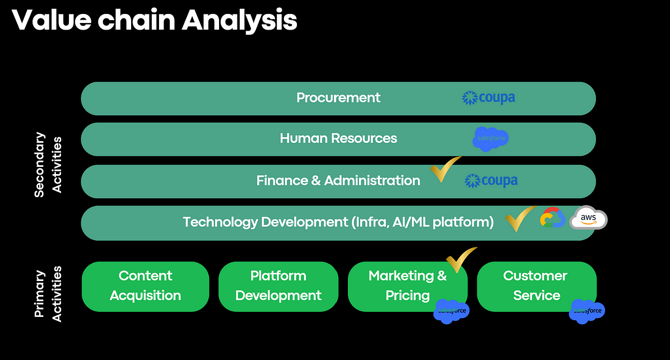Product Management News
Architecturesideas
185

Image Credit: Architecturesideas
8 Different Types of Stone Tiles for Home Design
- Different types of stone tiles can enhance the look and value of your property.
- From slate to marble, each type offers unique benefits, textures, and colors.
- Slate is heat resistant and nonslippery, while marble exudes elegance and class.
- Granite, limestone, sandstone, quartzite, and bluestone are also durable and versatile options.
- These stones cater to various aesthetic preferences and functional needs for homes and properties.
Read Full Article
11 Likes
Medium
114

Prioritize Features Like a Pro: Lessons They Don’t Teach You in Product School
- Feature prioritization in real life involves navigating opinions, incomplete data, market shifts, and tech constraints.
- It's crucial to balance a product vision with the team's beliefs and avoid just reacting to noise.
- Prioritization should involve curation, not just collection, and may require pushing certain features higher on the list for long-term value.
- The recommended approach includes aligning early, explaining often, adjusting together, prioritizing with empathy, executing with clarity, and iterating with courage.
Read Full Article
6 Likes
Medium
150

Image Credit: Medium
PM Breakdown: Cloudflare — Monetizing the Internet’s Traffic
- Cloudflare faces the challenge of strengthening its economic layer to match the size of its network.
- The company caters to a diverse user base with varying needs across technical and business teams.
- While Cloudflare's products perform well, there are areas that need improvement and refinement.
- By implementing smart upgrades and focusing on clear, actionable metrics, Cloudflare can enhance its platform's power, reliability, and trust among users.
Read Full Article
8 Likes
Medium
181

Image Credit: Medium
Boost Profits Instantly with QuickVSL Bundle - OneTime!
- QuickVSL Bundle - OneTime offers an AI-powered solution for creating professional VSLs.
- Priced at $297 for lifetime access, it simplifies VSL creation for marketers and content creators.
- Features include AI script generation, script-to-slide conversion, and no technical skills required.
- The platform is versatile, scalable for multiple projects, and proven to boost conversions.
Read Full Article
10 Likes
Discover more
- Programming News
- Software News
- Web Design
- Devops News
- Open Source News
- Databases
- Cloud News
- Operating Systems News
- Agile Methodology News
- Computer Engineering
- Startup News
- Cryptocurrency News
- Technology News
- Blockchain News
- Data Science News
- AR News
- Apple News
- Cyber Security News
- Leadership News
- Gaming News
- Automobiles News
Medium
8

Image Credit: Medium
Why Should Companies Transition Towards a “Product Operating Model”?
- Marty Cagan defines the 'Product Operating Model' based on experimentation and prioritizing innovation.
- Transitioning brings benefits in organizational areas and requires a strong CEO commitment.
- Product vision, strategy, and the CEO's role are crucial in successful transformation.
Read Full Article
Like
Medium
160

Image Credit: Medium
What Spotify Taught Me About Strategy, AI, and User Experience
- Spotify faces challenges such as providing bad recommendations and relying heavily on ads and subscriptions for revenue.
- Issues with user experience include buggy playback, repetitive songs, and unwanted podcasts.
- Proposed solutions include using smarter machine learning, dynamic pricing, and improving system stability.
- Recommendations also involve redesigning Spotify's user flow, leveraging ML engines like Vertex AI, and moving towards a retrieval and re-ranking approach.
Read Full Article
9 Likes
Medium
240

Image Credit: Medium
The Rise of Product Management in Tech Startups: Why Engineers Are Leading the Charge
- Product management in tech startups is seeing a shift as engineers are taking on more PM roles, blending technical and business expertise.
- The rise of product management is driven by the need for fast decision-making, deeper user understanding, and centralized team leadership in today's agile startup environment.
- Engineers make excellent product managers due to their system thinking, problem-solving skills, trade-off analysis abilities, and empathy for user-centered design.
- The author, a BTech student exploring product management, is preparing to pursue a Master's in Engineering Management to bridge technical knowledge with product thinking and plans to share insights from this journey.
Read Full Article
14 Likes
Medium
122

Image Credit: Medium
From Tasks to Vision: Building Product with Strategy, Not Just Speed
- Many product teams focus on tasks and milestones rather than connecting them to outcomes and a larger strategy.
- Skipping strategy leads to disconnected pieces in product development, like floors without houses or roofs without support.
- A strong product strategy aligns teams, acts as a blueprint for progress, and should be anchored to the purpose of the project.
- Leadership plays a crucial role in empowering product managers to lead with vision and ask essential questions about the direction of projects.
Read Full Article
7 Likes
Medium
266

Image Credit: Medium
From Doubt to Determination: How Favour Eniojukan Found Her Confidence and Career in Tech
- Favour Eniojukan transitioned from marketing to product management, attributing her success to She Code Africa's support.
- She Code Africa's Academy program provided personalized mentorship, live sessions, and access to data stipends, removing barriers for Favour's participation.
- Through the Academy, Favour gained confidence, skills in product management, and a paid internship opportunity that eventually led to a full-time job in tech.
- Favour is now a Product Manager at Traction Apps — Omnipay, illustrating how She Code Africa helped her overcome self-doubt and thrive in her career.
Read Full Article
16 Likes
Medium
194

“The Title Says Manager. The Behaviour Says Middleman.”
- Middleman Managers prioritize titles over real leadership, often acting as intermediaries without taking ownership.
- They rely on escalation tactics and endless meetings, lacking the ability to make decisions and guide the team effectively.
- True leadership involves taking ownership, empowering the team to propose solutions, and making decisive calls when necessary.
- Managers should focus on coaching their team to think like owners, reduce dependency, and actively solve problems instead of just forwarding emails.
Read Full Article
11 Likes
Medium
224

Image Credit: Medium
The Hive: The Ultimate Model for a Radically Efficient Organization
- The model of a hive is presented as an ultimate guide to an efficient organization, with the Queen symbolizing a CEO who focuses on long-range planning and trusts the team for daily operations.
- The scout bee, representing the Product Manager, plays a crucial role in ensuring clarity in vision and communication within the organization, streamlining processes and eliminating the need for constant follow-ups.
- The worker bees in the hive, analogous to the engineering team, work effectively due to the clarity provided by the PM, allowing them to execute tasks swiftly and with trust, leading to a high-performing organization.
- The hive model emphasizes trust, data-driven decision-making, and clearly defined roles as the key elements for success, enabling the organization to cut through corporate noise and achieve impactful results.
Read Full Article
13 Likes
Medium
63

Vision, Mission & Principles: The Foundation of Every Great Product Strategy
- Having a clear vision, mission, and guiding principles is essential for a successful product strategy.
- Vision serves as the product's north star, guiding teams towards a bold and meaningful future.
- Mission connects the current work to the larger goal, helping teams stay focused on the right problems.
- Principles assist in decision-making and guide consistent progress, ensuring alignment with the mission.
Read Full Article
3 Likes
Medium
33

Image Credit: Medium
Fog of Knowledge
- Living in the age of information overload, the 'Fog of Knowledge' hinders learning.
- Multiple opinions and sources lead to confusion, doubt, and decision-making paralysis.
- Habits to combat the fog include setting clear objectives, limiting inputs, and reflecting.
- Recognizing the need for reliable filters and context-aware insights to navigate efficiently.
Read Full Article
2 Likes
Medium
42
Image Credit: Medium
Food Aid Sparks Backlash in Japan, the World’s Thinnest Nation
- Japan, known for its low obesity rates, is facing a debate on expanding food aid due to rising food insecurity among different demographics.
- Food aid use in Japan has increased by over 30% from 2020 to 2025, driven by economic stress and an aging population.
- Critics argue that food aid programs in Japan may conflict with its health-conscious food culture and traditional diet rich in fish, rice, and vegetables.
- There are cultural resistance and concerns about social stigma, fear of dependency, and the impact of donated Western foods on the traditional Japanese diet.
Read Full Article
2 Likes
Medium
338

Image Credit: Medium
PMs: Culture, Code, Coffee & Chaos
- Shefali implemented a no-slack-pings-post-7PM rule and prioritized team well-being over strict deadlines, leading to a better product outcome.
- The startup where Shefali worked has now scaled, and her culture of thoughtful urgency still influences the organization.
- Product roadmaps reflect a company's culture, and each shipped feature communicates what the team values.
- Good PMs ensure that rituals within teams translate into establishing lasting organizational culture.
Read Full Article
20 Likes
For uninterrupted reading, download the app